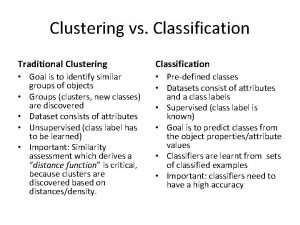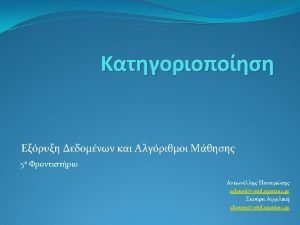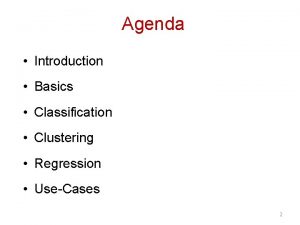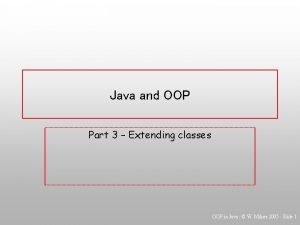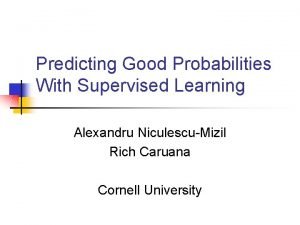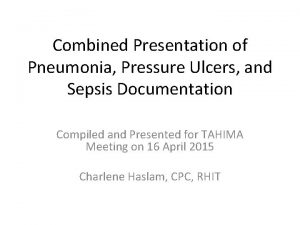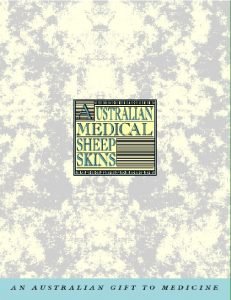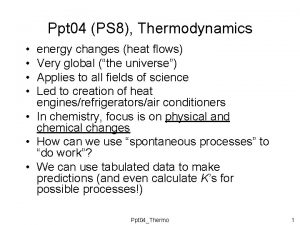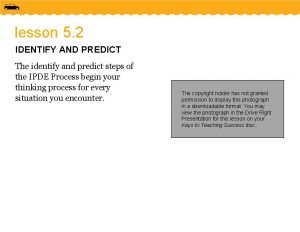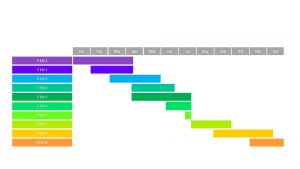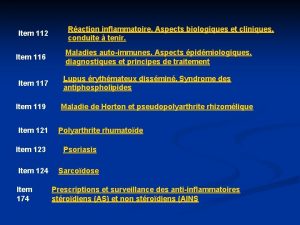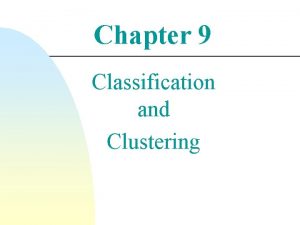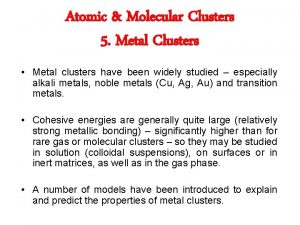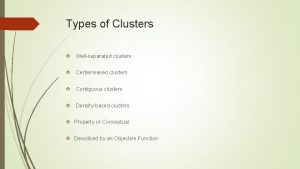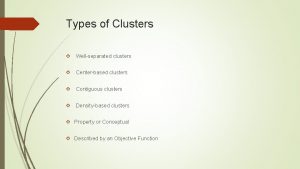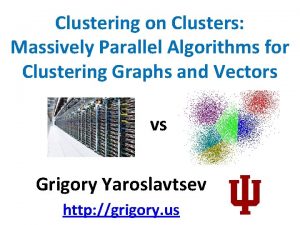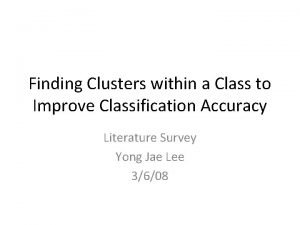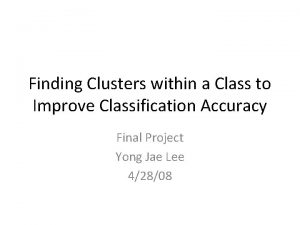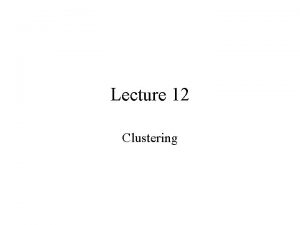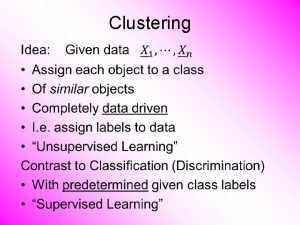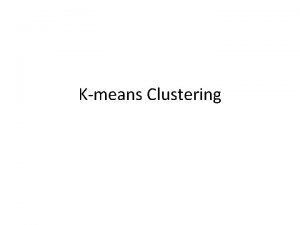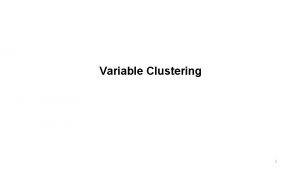Classification predicting an item class Clustering finding clusters





































- Slides: 37


Βασικοί Στόχοι της Εξόρυξης Δεδομένων �Classification: predicting an item class �Clustering: finding clusters in data �Associations: e. g. A & B & C occur frequently �Visualization: to facilitate human discovery �Summarization: describing a group �Deviation Detection: finding changes �Estimation: predicting a continuous value �Link Analysis: finding relationships �…

Data Mining �Data Mining is an interdisciplinary field involving: �– Databases �– Statistics �– Machine Learning �– High Performance Computing �– Visualization �– Mathematics



Classification VS Clustering Classification Clustering �Supervised Learning �Unsupervised Learning


Οπτικοποίηση (Visulization) �Σκοπός: Η οπτικοποίηση των δεδομένων για να διευκολυνθεί η κατανόηση συσχετίσεων �Π. χ. Self-Organizes Maps (SOMs) �SOMs are commonly used as visualization aids. They can make it easy for us humans to see relationships between vast amounts of data �A SOM has been used to classify statistical data describing various quality-of-life factors such as state of health, nutrition, educational services etc.

Οπτικοποίηση (Visulization) � Countries with similar quality-of-life factors end up clustered together. The countries with better quality-of-life are situated toward the upper left and the most poverty stricken countries are toward the lower right. Each hexagon represents a node in the SOM.

Οπτικοποίηση (Visulization) �This colour information can then be plotted onto a map of the world like so:







4) k-πλησιέστεροι γείτονες � The k-NN Rule: If the number of pre-classified points is large it makes good sense to use, instead of the single nearest neighbor, the majority vote of the nearest k neighbors. This method is referred to as the k-NN rule. �The number k should be: 1) large to minimize the probability of misclassifying x 2) small (with respect to the number of samples) so that the points are close enough to x to give an accurate estimate of the true class of x �Παραλλαγές: Weighted K-nn





Μετρικές Ακρίβειας �Sensitivity or true positive rate (TPR) eqv. with hit rate, recall TPR = TP / P = TP / (TP + FN) �False positive rate (FPR) eqv. with fall out FPR = FP / N = FP / (FP + TN) � Accuracy ACC = (TP + TN) / (P + N) �Positive predictive value (PPV) eqv. with precision PPV = TP / (TP + FP) actual value predi ction outc ome total p n total p' True False Posit ive P' n' False True Nega tive N' P N

F - score �The F score can be interpreted as a weighted average of the precision and recall, where an F score reaches its best value at 1 and worst score at 0. �The traditional F-measure or balanced F-score (F score) is the harmonic mean of precision and recall:

Overfitting/Overtraining in supervised learning (e. g. neural network). Training error is shown in blue, validation error in red. If the validation error increases while the training error steadily decreases then a situation of overfitting may have occurred.













 Flat vs hierarchical clustering
Flat vs hierarchical clustering Partitional clustering vs hierarchical clustering
Partitional clustering vs hierarchical clustering Rumus distance
Rumus distance Metafora adalah
Metafora adalah Clustering vs classification
Clustering vs classification Clustering vs classification
Clustering vs classification Clustering vs classification
Clustering vs classification Classification and clustering in data mining
Classification and clustering in data mining Classification regression clustering
Classification regression clustering Classification and clustering
Classification and clustering Oop java
Oop java Choose the correct item it's no use to try
Choose the correct item it's no use to try Predicting products of chemical reactions
Predicting products of chemical reactions Predicting products of chemical reactions
Predicting products of chemical reactions Predicting products of chemical reactions
Predicting products of chemical reactions Alexandru niculescu-mizil
Alexandru niculescu-mizil Section 3 predicting the products of chemical reactions
Section 3 predicting the products of chemical reactions Braden score meaning
Braden score meaning Makalah previewing and predicting
Makalah previewing and predicting Braden scale for predicting pressure sore risk
Braden scale for predicting pressure sore risk Apa itu previewing and predicting
Apa itu previewing and predicting Prediction pip
Prediction pip Predicting pip
Predicting pip Vsepr theory is a model for predicting
Vsepr theory is a model for predicting Single replacement products
Single replacement products Thermodynamics ppt
Thermodynamics ppt Predicting spontaneity
Predicting spontaneity Pleasure predicting sheet
Pleasure predicting sheet Predicting spontaneity
Predicting spontaneity Predicting science process skills
Predicting science process skills Science process skills predicting
Science process skills predicting Predicting products
Predicting products Predicting precipitation reactions
Predicting precipitation reactions Predicting content in listening
Predicting content in listening The evolution of crm is reporting analyzing and predicting
The evolution of crm is reporting analyzing and predicting Observing and classifying
Observing and classifying Communicating science process skills
Communicating science process skills Searching for specific driving-related clues
Searching for specific driving-related clues





